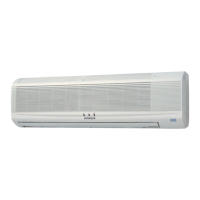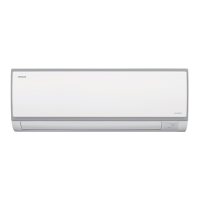Do you have a question about the Hitachi RPK-2.0FSN3M and is the answer not in the manual?
Information regarding reproduction, transmission, and modification rights of the publication.
Information about product identification and classification.
Check model, system type, code, and reference for installation and operating manuals.
Details on unit type, hyphen, capacity, refrigerant type, and model classification.
Details on power range and combinations of FSXN1E outdoor units.
Details on power range and combinations of FSXNH outdoor units.
Explanation of symbols used for safety, cautions, and notes in the manual.
Important safety precautions regarding electrical shock, handling, and modifications.
Information about pressure vessel safety, high pressure switch, and potential hazards.
Specifies the design temperature ranges for cooling and heating operations.
Details functions like three-minute protection, frost prevention, auto defrost, and hot start.
Diagram and list of parts for the RAS-8FSXN1E outdoor unit.
Diagram and list of parts for the RAS-(10/12)FSXN1E outdoor unit.
Diagram and list of parts for the RAS-(14/16)FSXN1E outdoor unit.
Diagram and list of parts for the RAS-(5/6)FSXNH(E) outdoor unit.
Diagram and list of parts for the RAS-(8-12)FSXNH(E) outdoor unit.
Refrigerant circuit diagram and parts list for RAS-(8-12)FSXN1E.
Refrigerant circuit diagram and parts list for RAS-(14/16)FSXN1E.
Refrigerant circuit diagram and parts list for RAS-(5/6)FSXNH(E).
Refrigerant circuit diagram and parts list for RAS-(8-12)FSXNH(E).
Instructions for securing and fastening the outdoor unit during transport.
Precautions for handling loads with fork-lift trucks to prevent injury or damage.
Guidelines for safely lifting the unit using hoisting slings and proper techniques.
Table showing center of gravity dimensions for various outdoor unit models.
Conditions for outdoor unit placement, considering sunlight, noise, access, and climate.
Calculations for required service space around the unit based on wall configurations.
Guidelines for installing the unit, including space requirements for different wall configurations.
Requirements for foundations and anchorage bolts for the outdoor unit.
Instructions for selecting refrigerant pipe sizes based on unit power and system type.
Specifications for copper pipes, including diameters, thicknesses, and insulation.
Precautions for installing outdoor units and refrigerant pipes, including order and spacing.
General guidelines for installing refrigerant pipes, including flared connections and insulation.
Instructions for connecting refrigerant pipes for heat pump and heat recovery systems.
Procedures and torque specifications for tightening stop valves and performing air-tight tests.
Steps for vacuum pumping the refrigerant system after piping work.
Method for calculating additional refrigerant charge based on pipe diameter, length, and unit capacity.
Table showing maximum additional refrigerant charge quantity by HP.
Calculation of additional refrigerant for wall type units with expansion valve kit.
Precautions and procedures for opening stop valves during refrigerant charging.
Procedure for performing the automatic refrigerant amount check operation.
Attention to critical gas concentration to prevent accidental leakage.
Safety precautions in the event of refrigerant leaks.
Details on maximum permitted concentration of HFC R410A gas in the air.
Formula for calculating refrigerant concentration in a room.
Measures for rooms in case of refrigerant leaks, including ventilation and fans.
Information on condensation buildup and drainage systems for outdoor units.
General precautions for electrical wiring work, including safety and protection.
Checks for electrical components, voltage, supply lines, and earth connection.
Wiring diagrams for connecting power sources to outdoor and indoor units.
Field minimum wire sizes for power source and transmission cables.
Electrical data and recommended wiring/breaker sizes per outdoor unit.
Specifications for service voltage, start-up voltage, voltage imbalance, and electromagnetic compatibility.
Instructions for connecting electrical wiring to the outdoor unit terminal board.
Connecting indoor units, CH units, and outdoor units via communication cables.
Diagram showing the location of DSW switches on PCB1.
Procedure for setting refrigerant cycle numbers using DSW1 and RSW1.
Setting for capacity configuration.
Procedure for setting outdoor unit numbers for combinations.
Setting for supply voltage.
Setting for communication parameters.
Settings for test run and service operations.
Settings for emergency operation, test run, and service.
Procedure for setting external inputs/outputs and functions via the menu.
Guide to selecting and setting external input/output functions.
Procedure for changing function settings using push-switches.
Essential checks before performing the test run, including wiring and refrigerant.
Steps for performing the test run on indoor and outdoor units.
Instructions for using the PC-ART remote controller for test run mode.
Instructions for using the PC-ARF remote controller for test run mode.
A checklist for verifying system operation and parameters during the test run.
Table listing common alarm codes, categories, contents, and possible causes.
Details on devices protecting the compressor, including pressure switches and oil heaters.
Describes normal operating sounds and minor issues not considered faults.
Checks to perform when the system is not operating.
Checks for faulty operation related to airflow, heat sources, filters, and doors/windows.
Information to provide to service personnel if problems persist.
| Brand | Hitachi |
|---|---|
| Model | RPK-2.0FSN3M |
| Category | Air Conditioner |
| Language | English |












